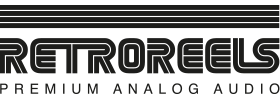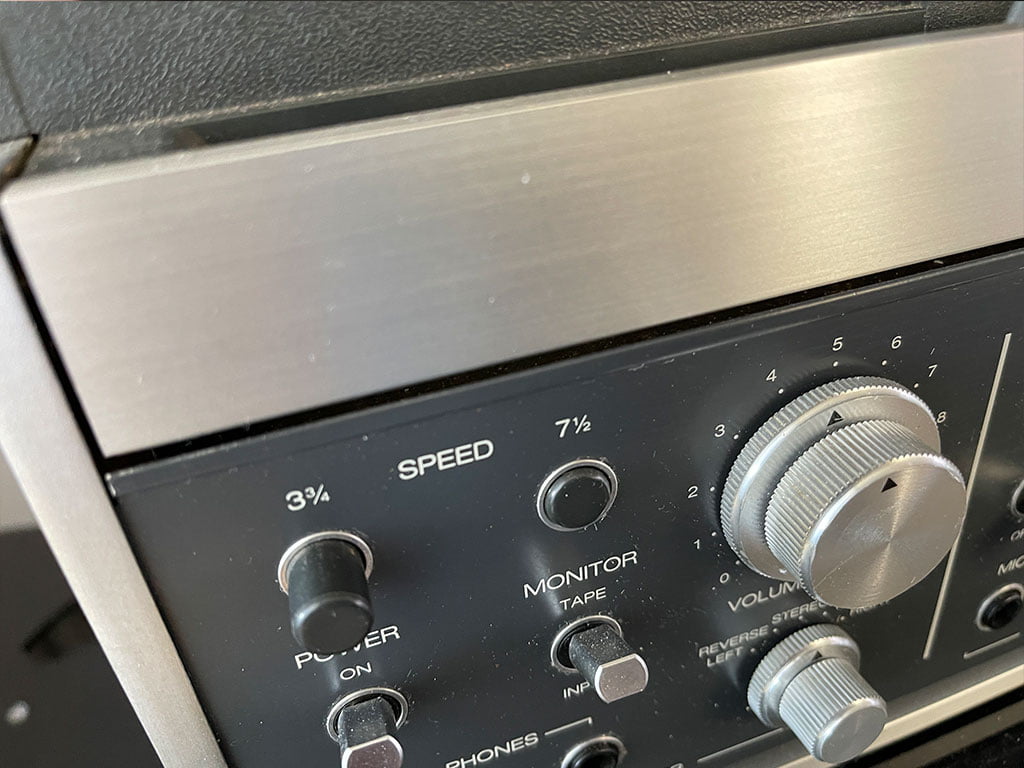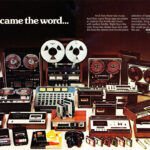Tape speed plays a crucial role in reel-to-reel audio recordings, significantly influencing the overall sound quality and characteristics of the music. When using a tape machine, it is important to understand the importance of tape speed and its impact on the final audio outcome.
There are various factors that can affect the sound quality in reel-to-reel machines, including reel-to-reel tape speed. The inch per second (IPS) at which the tape moves across the tape head is a key parameter in tape machines. Different tape speeds have different effects on sound. For example, slower speeds like 3.75 IPS can darken the sound and boost the low end, while faster speeds like 15 IPS introduce tape saturation and eliminate digital harshness. Higher speeds, such as 30 IPS, provide a clean sound with less distortion and more dynamic range.
Track width also plays a role in sound quality. It influences the dynamic range and provides protection against dropouts. The interaction between tape speed and track width affects various aspects of sound quality, including frequency response, dynamic range, and distortion characteristics.
In addition to reel-to-reel machines, tape emulation plugins are widely used to replicate the vintage tape machine vibe. These plugins closely mimic the characteristics of tape machines, including the roll-off on the top end, the glue and dimension of tape machines, and the saturation effect. Some popular tape emulation plugins include Slate Digital VTM, Waves J37, and Universal Audio Ampex ATR-102 Master Tape.
To further enhance the analog warmth and tape effects, saturation plugins can be utilized. These plugins add warmth and mimic the saturation effects of tape. Recommended saturation plugins include Crane Song Phoenix II, SoundToys Decapitator, and Universal Audio Culture Vulture. Outboard processors and gear, such as Rupert Neve Designs Portico 542 and Thermionic Culture Vulture, can also provide analog warmth and tape emulation.
Key Takeaways:
- Tape speed significantly impacts sound quality in reel-to-reel audio recordings.
- Different tape speeds have varying effects on sound, such as darkening the sound or introducing tape saturation.
- Track width influences dynamic range and provides protection against dropouts.
- Tape emulation plugins can closely replicate the vintage tape machine vibe.
- Saturation plugins can add analog warmth and mimic the effects of tape.
Factors Affecting Sound Quality in Reel-to-Reel Machines
Sound quality in reel-to-reel machines can be influenced by several factors, including tape speed, reel-to-reel tape variations, and the quality of the machine’s heads and tape formula. Understanding these factors is crucial for achieving the desired audio outcome when using tape machines or tape emulation plugins.
One of the key factors that affect sound quality is tape speed. The speed at which the tape moves across the tape head, measured in Inches Per Second (IPS), has a significant impact on the overall sound. Different tape speeds produce different sonic characteristics. For example, slower speeds like 3.75 IPS can darken the sound and enhance the low end, while faster speeds like 30 IPS provide a cleaner sound with less distortion and more dynamic range.
Another factor to consider is reel-to-reel tape variations. The size and formula of the tape can affect the sound quality and the recording’s overall tone. Different tape formulations offer different sonic characteristics, such as warmth or brightness. Additionally, the quality of the machine’s heads, which are responsible for the playback and recording of the audio, can greatly influence sound quality. Well-maintained and properly aligned heads can deliver clearer and more accurate sound reproduction.
In summary, when working with reel-to-reel machines, it is important to pay attention to various factors that can affect sound quality. These include tape speed, reel-to-reel tape variations, and the quality of the machine’s heads and tape formula. By understanding and optimizing these factors, you can achieve the desired audio outcome, whether you are using a physical tape machine or tape emulation plugins.
The Influence of Tape Speed on Sound Quality
Tape speed has a notable impact on the sound quality of reel-to-reel recordings, and understanding how to adjust and utilize different tape speed settings is essential for optimizing audio output. The IPS (Inch Per Second) at which the tape moves across the tape head is a key parameter in tape machines, and different IPS speeds can result in varying sound characteristics.
For example, when recording at a speed of 3.75 IPS, the sound tends to darken and the low end is boosted. On the other hand, recording at 15 IPS introduces tape saturation and helps to eliminate digital harshness. Higher speeds, such as 30 IPS, provide a cleaner sound with less distortion and a wider dynamic range.
In addition to tape speed, the track width also plays a role in sound quality. The track width influences the dynamic range and provides protection against dropouts, enhancing the overall fidelity of the recording. The interaction between tape speed and track width affects various aspects of sound quality, including frequency response, dynamic range, and distortion characteristics.
Adjusting Tape Speed and Utilizing Different Tape Speed Settings
When using reel-to-reel machines, it is crucial to understand how to adjust and utilize different tape speed settings. Experimenting with different speeds can help achieve the desired audio outcome. To optimize sound quality, it is important to consider the overall tone and vibe you wish to achieve.
For a vintage tape machine vibe, tape emulation plugins can closely replicate the sonic qualities of traditional tape machines. Some popular tape emulation plugins, such as Slate Digital VTM, Waves J37, and Universal Audio Ampex ATR-102 Master Tape, recreate the roll-off on the top end, the glue and dimension of tape machines, and the saturation effect.
Alternatively, saturation plugins can also be used to add analog warmth and mimic the effects of tape. Recommended saturation plugins include Crane Song Phoenix II, SoundToys Decapitator, and Universal Audio Culture Vulture. Outboard processors and gear, such as Rupert Neve Designs Portico 542 and Thermionic Culture Vulture, are also effective in providing analog warmth and tape emulation.
Understanding tape speed and its impact on sound quality is essential for achieving the desired audio outcome when using tape machines or tape emulation plugins. Whether recording onto physical tape or using virtual tape plugins, exploring different tape speeds and settings allows for creative experimentation and the ability to craft unique sounds.
Tape Speed and Track Width Interactions
The relationship between tape speed and track width in reel-to-reel machines plays a significant role in shaping the overall sound characteristics, including frequency response, dynamic range, and distortion levels. Different tape speeds, such as 3.75 inches per second (IPS), 7.5 IPS, 15 IPS, and even higher speeds like 30 IPS, offer distinct sonic possibilities.
At slower speeds like 3.75 IPS, the sound tends to become darker, with a noticeable boost in the low end frequencies. This can be desirable for creating a warmer and more vintage sound. On the other hand, higher tape speeds like 15 IPS introduce tape saturation, which can add a pleasing harmonic distortion and help eliminate digital harshness. Speeds above 15 IPS, such as 30 IPS, provide a cleaner sound with less distortion and a wider dynamic range.
“Different tape speeds offer distinct sonic possibilities, from warmer vintage tones to cleaner and more dynamic sounds.”
In addition to tape speed, track width also plays a crucial role in sound quality. A wider track width allows for more accurate reproduction of the recorded signals and provides better protection against dropouts, resulting in a cleaner and more detailed sound. Narrower track widths, on the other hand, may introduce more noise and reduce dynamic range.
Frequency response, dynamic range, and distortion characteristics
- The tape speed can affect the frequency response of a recording. Slower speeds tend to emphasize the lower frequencies, while higher speeds provide a more balanced and extended frequency range.
- Dynamic range, which refers to the difference between the quietest and loudest sounds a tape machine can capture, is influenced by both tape speed and track width. Higher speeds and wider track widths generally offer a wider dynamic range.
- Distortion characteristics also vary with tape speed. Slower speeds can introduce more tape saturation and harmonic distortion, while higher speeds tend to produce cleaner sound with less distortion.
Understanding the interactions between tape speed and track width is crucial for capturing the desired sound and achieving maximum audio quality when using reel-to-reel machines or tape emulation plugins. By selecting the appropriate tape speed and track width settings, you can shape the tone, dynamic range, and overall character of your recordings.
Tape Emulation Plugins for Achieving Vintage Tape Effects
To achieve the warmth and character of vintage tape machines, tape emulation plugins can be employed, allowing users to recreate the unique effects of reel-to-reel tape speed and capture the sonic qualities of classic recordings. These plugins serve as powerful tools for adding depth, richness, and that sought-after vintage vibe to digital audio productions.
When it comes to tape emulation plugins, there are several popular options available that have gained recognition for their ability to replicate the characteristics of reel-to-reel tape machines. One such plugin is the Slate Digital VTM, which faithfully emulates the sound of classic tape machines and provides users with control over tape speed, tape formula, and various other parameters.
Another widely-used tape emulation plugin is the Waves J37, which models the iconic sound of the vintage tape machine used at Abbey Road Studios. This plugin offers an array of features, including tape saturation, wow/flutter effects, and the ability to adjust tape speed and bias, allowing users to add warmth and vintage charm to their recordings.
Recommended Tape Emulation Plugins:
- Slate Digital VTM
- Waves J37
- Universal Audio Ampex ATR-102 Master Tape
These plugins, along with many others on the market, offer a range of options for users seeking to recreate the sonic qualities of reel-to-reel tape machines. They provide control over tape speed and other relevant parameters, allowing for experimentation and customization to achieve the desired vintage tape sound.
It’s worth noting that tape machines generate not only warm tones but also heat, movement, and noise, all of which contribute to the unique character of recordings made on tape. While tape emulation plugins can faithfully recreate the sonic qualities of vintage tape machines, they do not replicate these physical aspects. However, they provide a convenient and flexible way to experiment with different combinations of effects and capture the essence of classic recordings.
In addition to tape emulation plugins, saturation plugins can also be used to add analog warmth and reproduce the effects of tape. Plugins like Crane Song Phoenix II, SoundToys Decapitator, and Universal Audio Culture Vulture are highly regarded for their ability to add depth, saturation, and vintage character to digital audio productions.
Recommended Saturation Plugins:
- Crane Song Phoenix II
- SoundToys Decapitator
- Universal Audio Culture Vulture
For those looking to go beyond plugins, outboard gear such as the Rupert Neve Designs Portico 542 and Thermionic Culture Vulture offer analog warmth and specific tape emulation capabilities. These pieces of gear can further enhance the sonic qualities and add a touch of vintage charm to recordings.
Understanding the impact of tape speed on sound quality and how tape emulation plugins provide a bridge to the vintage tape machine experience is essential for audio producers and enthusiasts seeking to achieve the desired audio outcome in their digital productions. With the wide range of tape emulation plugins available today, capturing the warmth, charm, and unique effects of vintage tape machines has never been more accessible.
Tape Emulation and Analog Warmth
In addition to tape emulation plugins, saturation plugins, and outboard gear can be utilized to introduce analog warmth and replicate the distinctive characteristics of tape recordings. The use of tape emulation plugins allows for the recreation of the roll-off on the top end, the glue and dimension of tape machines, and the saturation effect that is often associated with analog tape. These plugins provide a flexible and convenient way to achieve the desired vintage tape machine vibe.
Some popular tape emulation plugins include Slate Digital VTM, Waves J37, and Universal Audio Ampex ATR-102 Master Tape. With these plugins, users can dial in different tape speeds, adjust the bias, and simulate the unique sonic qualities of various tape machines. They offer the ability to experiment with different combinations of effects and create a wide range of sounds.
When it comes to adding analog warmth and replicating the effects of tape, saturation plugins are another valuable tool. Saturation plugins such as Crane Song Phoenix II, SoundToys Decapitator, and Universal Audio Culture Vulture can introduce harmonic distortion, subtle compression, and a vintage coloration to audio recordings. These plugins can bring out the richness and depth in the sound, mimicking the warmth and character of tape recordings.
In addition to tape emulation and saturation plugins, outboard processors and gear can also contribute to the analog warmth and tape emulation process. Equipment like Rupert Neve Designs Portico 542 and Thermionic Culture Vulture provide additional options for adding warmth and character to recordings. By utilizing these tools, engineers and musicians can achieve the desired vintage tape sound and enhance the overall audio quality.
Conclusion
Understanding tape speed and its impact on sound quality is essential for achieving the desired audio outcome when using tape machines or tape emulation plugins. By utilizing tape emulation plugins, saturation plugins, and outboard gear, it is possible to introduce analog warmth, replicate the distinctive characteristics of tape recordings, and create a unique and vintage sound.
Conclusion
Understanding the influence of tape speed in reel-to-reel machines is vital for optimizing sound quality and ensuring an exceptional audio output. When using a tape machine, various factors can affect the sound of a recording, including reel-to-reel quality, heads, formula, and size of the tape, BIAS, and alignment. However, one of the key parameters that significantly impacts sound quality is the IPS (Inch Per Second) at which the tape moves across the tape head.
Different IPS speeds have varying effects on the sound. For instance, a tape speed of 3.75 IPS can darken the sound and boost the low end, whereas 15 IPS introduces tape saturation and eliminates digital harshness. Higher speeds, like 30 IPS, provide a clean sound with less distortion and more dynamic range.
Track width also plays a crucial role in achieving optimal sound quality. It not only influences dynamic range but also provides protection against dropouts. Additionally, tape speed and track width interact with frequency response, dynamic range, and distortion characteristics, further shaping the overall sonic experience.
While tape machines have their unique sonic qualities, the use of tape emulation plugins can closely replicate the vintage tape machine vibe. Popular tape emulation plugins, such as Slate Digital VTM, Waves J37, and Universal Audio Ampex ATR-102 Master Tape, can recreate the roll-off on the top end, the glue and dimension of tape machines, and the saturation effect, allowing for flexibility and experimentation in achieving desired audio effects.
Furthermore, to add analog warmth and mimic the effects of tape, saturation plugins like Crane Song Phoenix II, SoundToys Decapitator, and Universal Audio Culture Vulture can be utilized. Outboard processors and gear, such as Rupert Neve Designs Portico 542 and Thermionic Culture Vulture, also provide analog warmth and tape emulation, contributing to the desired audio outcome.
With the knowledge and understanding of tape speed and its impact on sound quality, audio professionals can make informed decisions when using tape machines or tape emulation plugins, ensuring maximum sound quality and creating exceptional audio experiences.
FAQ
Why is understanding tape speed important when using a tape machine?
Understanding tape speed is crucial for achieving the desired sound quality in recordings. Different tape speeds have varying effects on the sound, such as darkening the sound, boosting the low end, introducing tape saturation, and providing a clean sound with less distortion and more dynamic range.
What factors can affect the sound quality in reel-to-reel machines?
Several factors can impact the sound quality in reel-to-reel machines, including reel-to-reel quality, heads, formula and size of the tape, BIAS, and alignment. These factors can influence the overall tone, frequency response, dynamic range, and distortion characteristics of the recording.
How does tape speed interact with track width?
Tape speed and track width interact to affect various aspects of sound quality. Different combinations of tape speed and track width can impact frequency response, dynamic range, and distortion characteristics. Additionally, track width provides protection against dropouts and can further enhance dynamic range.
Can tape emulation plugins replicate the vintage tape machine vibe?
Yes, tape emulation plugins can closely replicate the vibe of vintage tape machines. These plugins can recreate the roll-off on the top end, the glue and dimension of tape machines, and the saturation effect. Popular tape emulation plugins include Slate Digital VTM, Waves J37, and Universal Audio Ampex ATR-102 Master Tape.
Are there other plugins or gear that can add analog warmth and mimic the effects of tape?
In addition to tape emulation plugins, saturation plugins can also add analog warmth and mimic the effects of tape. Recommended saturation plugins include Crane Song Phoenix II, SoundToys Decapitator, and Universal Audio Culture Vulture. Outboard processors and gear, such as Rupert Neve Designs Portico 542 and Thermionic Culture Vulture, can also provide analog warmth and tape emulation.
What are some important considerations when using tape machines or tape emulation plugins?
It’s important to note that tape machines generate heat, movement, and noise, which can change the tone of the recording. Calibration and setting of bias are also necessary for optimal performance. When using tape emulation plugins, experimentation is encouraged to achieve different combinations of effects and desired audio outcomes.


















